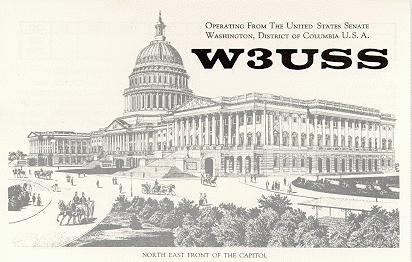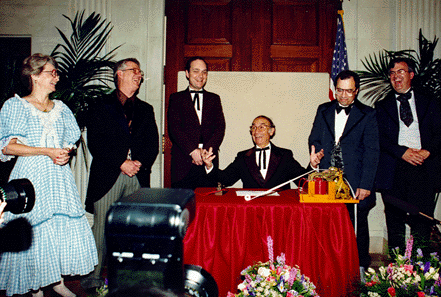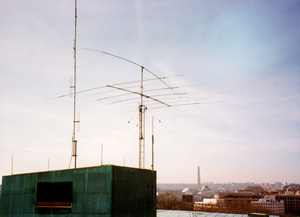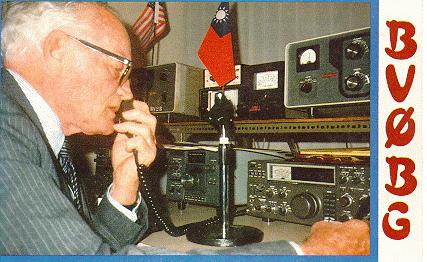[As of April 30, 1999, the Capitol Hill Amateur Radio Society disbanded. The callsign W3USS will be retained by the trustee until its use is warranted. An article on the closing of the Club appears at the bottom of this page.]

Capitol Hill Amateur Radio Society (W3USS)
Updated November 3, 2006
ORIGINS AND PURPOSE
The Capitol Hill Amateur Radio Society (CHARS) is a NONPARTISAN organization of Capitol Hill employees who have been licensed by the Federal Communications Commission (FCC) after successfully completing an examination on their proficiency in radio communications knowledge and skills. The association began in 1968 when an aide to then-Senator Sparkman placed an article in the Capitol Hill newspaper ROLL CALL requesting that other radio Amateurs working on Capitol Hill contact him. A number of radio Amateurs from various offices did so, and formed an informal luncheon group. Senator Goldwater joined the group when he returned to the Senate in 1969.
CHARS was formally established in 1969 when its charter was signed and organizational bylaws adopted. At those early meetings, Senator Goldwater, who at that time maintained at his home in Arizona, one of the largest military-affiliated Amateur Radio stations in the world, proposed that a station be established in one of the Senate office buildings. It would be "established, operated, and maintained by Club members, on a purely voluntary basis, without use of any government funds," to ensure that there would be the equipment and operators, or persons with direct access through connections with the radio Amateur community at large, for the following purposes:
- To establish a station capable of restoring communications in the event of a natural disaster in the Washington, D.C. area, with priority for Capitol Hill Police and other security interests; communications requested by or on behalf of a Senator, Member, or committee; communications for any other governmental agency; and communications for members of the general public relating to the disaster;
- To provide emergency communications to and from areas of natural disaster, with first priority accorded official government messages related to relief efforts, second priority for messages requested by any Senator, Member, or committee, relating to information concerning the extent of damage, statistics, etc., or to attempts by constituents to establish contact with family or friends in the affected area;
- To provide telephone connections ("patches") for military personnel and other parties located in overseas areas who otherwise would not be able to speak with their family members; and
- To establish contact with Amateur stations in all parts of the United States, and worldwide, as a goodwill gesture.
Later, in 1969, the station was established and associated antennas were located on the roof of the Russell Senate Office Building. The original station equipment was donated personally by Senator Goldwater, some of which is still in use at the station today.
Over the years, Club members have worked to improve the Club station and keep it actively "on the air." Today, it is very well known in Amateur circles. The station is capable of worldwide Amateur communications, and, through the Military Affiliate Radio System, can connect into the volunteer military networks. All of the equipment and antennas used by the station continue to be donated by the members or purchased with their dues. The dues also are used for printing and postage costs.
Daily operation and maintenance of the station ensures that both the equipment and skilled operators necessary to carry out any communications task are available—either by CHARS' members themselves, or through associates of the members should any communications requirement exceed the immediate resources. For example, should police repeater communications fail, within hours, the local network can be reconstituted using Amateur equipment and frequencies. This would be the only way it could be re-established in such a short time. This is possible because Amateurs purchase and use equipment that is functionally equivalent to that used by police. At times when emergency communications are required—and such events not infrequently occur even in the technologically sophisticated United States—radio Amateurs have an unparalleled record of volunteering their equipment and frequencies for public purposes. Indeed, it is to promote the availability of this equipment and expertise that valuable radio spectrum has always been allocated to radio Amateurs. Not only is scarce radio spectrum allocated to radio Amateurs in the United States, but it is so allocated in almost every country in the world, for similar underlying reasons.
Thus, the service and goodwill aspects that occupy CHARS' day-to-day affairs ensure that equipment, antennas, and skilled operators are available to perform communication tasks during times of disaster when normal communication links fail. Hopefully no such disaster will ever occur here in Washington, but if it should, the station is ready to provide whatever communications may be desired. When originally installed, the station was placed on the Capitol system's emergency electrical power circuit for this reason. In the recent past, when natural disasters have struck other areas, such as the volcanic eruption in Colombia, the earthquake in Mexico, Operation Desert Storm, and, most recently, the devastating earthquake in California, this station was used to communicate with Amateurs in the affected areas. Normal Amateur practice dictates that after emergency messages (regarding damage reports and assistance requests), messages regarding the status of individuals should be exchanged. During such times, we have worked with similar Amateur stations that exist at the Smithsonian Institution (NN3SI), the Voice of America (K3VOA), the Pentagon (K4AF), and the Department of State (W3DOS).
Locally, our call sign has been used for several special events: At Fort McHenry, Baltimore, during the week of September 9-16, 1989, to mark the 175th Anniversary of the Battle of Baltimore and the Writing of the Star Spangled Banner; during the weekend of January 15-18, 1993, in celebration of the inauguration of Bill Clinton and on January 17-20, 1997, for his second inauguration; on several occasions, we've joined with area Hams at their Field Day sites; and annually, on St. Clement's Island in the lower Potomac River (St. Mary's County, MD) at the "Blessing of the Fleet" which commemorates the landing of the first English-speaking settlers seeking political and religious freedom (March 25, 1634).
On Thursday, May 23, 1991, our Club sponsored the Bicentennial Celebration of the birth of Samuel F. B. Morse in the Capitol of the United States. A part of the program was a re-enactment of the transmission: "What hath God wrought!" Pictured below, dressed in clothes of the era, are Mrs. Jo Ann Morse, Judge Robert F. B. Morse (great-great-grandson of Samuel), Dave Siddall (K3ZJ), Architect of the Capitol George M. White (W3HDO), Bill Hider (N3RR), and Frank Donovan (W3LPL).

George R. Stephens (W3GRS)
President
Views of the Shack and our antennas. (These antennas were taken down in May of 1999)


U.S. Senator Barry Goldwater (K7UGA) led a group of Club members to Taiwan the first week of January 1986. The BV0BG station was established in Taipei, the capital city with a population of over 2 million people. Among the 7,000 QSO's made all over the world in 7 days were the first ever from BV on 80 and 160 meters. Members of the team were Jeff (W4PBC), Larry (W3HHG), Dave (K3ZJ), Roland (K4OCI), Tom (K3TW), and Karl (K4YT).

If you have any comments, address them to: W3GRS
Take a tour of the U.S. Capitol
Visit the Library of Congress
An extensive listing of Amateur Clubs can be viewed by clicking on the following:
The following article on the closing of the Club appeared in Roll Call on Monday, April 26, 1999.
PDF Version of Story
return to top
Radio Days
No Longer Hamming It Up
Capitol Hill Amateur Radio Society Closing Shop
By Amy Keller
Crouched in a broom-closet-sized room hidden under a staircase in
the Russell Senate Office Building, longtime Senate aide George
Stephens points to the sign that says it all.
"W3USS -- I affectionately refer to it as `Whiskey Three
Uncle Sugar Sugar,'" says Stephens, a ham radio operator who has
served as the Government Printing Office's liaison to the Senate
Republican Policy Committee for the past 18 years.
"W3USS" is the call sign for the Senate's amateur radio
station. But when Stephens retires at the end of this month, so
retires the signal for W3USS.
Stephens, 64, has been running the Capitol Hill Amateur Radio
Society for the past 13 years, but after 30 years of operation,
the club is closing its doors.
It may be surprising to some that the ham radio club -- which
was formally established with then-Sen. Barry Goldwater's
(R-Ariz.) support in 1969 -- has managed to survive at all in
recent years, especially in an era dominated by the Internet and
cell phones.
But it isn't surprising to Stephens.
In his opinion, those modern-day conveniences just don't
measure up to ham radio.
"To me, the Internet has made introverts out of people," says
Stephens. "It has drawn people in. Amateur radio to me, is
something that brings people out."
But the Capitol Hill radio group will not survive the exit of
Stephens, who began his 18 years of service to the Senate's
Republican Policy Committee as a printer/proofreader in 1981.
That's also when he joined the association.
In its heyday, the group had about 20 members. Today there
only five left, and that's why the club has reached its end
point.
Stephens sadly explains that of the continuing members, the
one who's closest to the club's small station in the Russell
Building works over in Postal Square. Another member of the club
works in the Ford Building, and neither are in close-enough
proximity to keep up with the demands of the job.
The club's beginnings trace back to 1968, when an aide to
then-Sen. John Sparkman (D-Ala.) placed an ad in Roll Call asking
other amateur radio operators working on the Hill to contact him.
Those who responded created an informal luncheon group. Then in
1969, Goldwater became a member and expanded the group's scope
and mission.
Goldwater, an avid ham radio operator who maintained his own
station at his home in Arizona, also helped secure operating
space for the club in a small cubbyhole under a stairwell in the
Russell Building -- a tiny space that "catches every grain of
dust in the stairway," Stephens noted.
According to the group's charter, Goldwater's aim was to
establish a station "capable of restoring communications in the
event of a natural disaster in the Washington, D.C., area" and
capable of providing "emergency communications" to and from
natural disaster areas.
Another function of the organization was to facilitate
telephone connections for military personnel and others overseas
who otherwise would not be able to speak with their family
members, as well as contact other amateur stations worldwide "as
a goodwill gesture."
And in recent years, the Capitol Hill Amateur Radio Society
has jumped into action when natural disasters have struck across
the planet. From Operation Desert Storm to the devastating
earthquakes that have rocked Mexico and California in recent
history, Stephens and the other "hams" have used the station to
communicate with other amateurs in the affected areas.
"We were on the air with health and welfare traffic,"
Stephens said, explaining that through radio contact he and other
concerned parties in the Senate were able to find out about
people's loved ones and to get general information flowing when
it could not be obtained in more traditional ways.
As for goodwill, there's been plenty of that spread across
the globe over the years by Capitol Hill's ham radio operators.
The evidence is collecting dust in the top drawer of an old
gray filing cabinet in the ham radio club's headquarters, where
hundreds of "QSL" cards -- postcards that ham radio operators
across the world exchange to celebrate contact they've made --
are arranged in neat rows.
The cards themselves are relics of a bygone era -- mailed to
the Senate years ago by ham radio operators from such places as
the former USSR, a nation known then as East Germany and a
Yugoslavia not yet ravaged by war.
Stephens fondly recalls his chats with other radio
enthusiasts around the world, recounting his periodic
communications over the years with a "guy in Riga, [Latvia,]
whose English is better than anyone I know."
Stephens also remembers when Members of Congress, such as
now-retired Sen. John Glenn (D-Ohio), would come in and use the
club's equipment to talk with students back in Ohio who were
learning about radio transmissions.
Stephens said he and the Capitol Hill Amateur Radio Club very
nearly got a chance to make contact with Glenn during his NASA
mission last year.
But the amateur club, says Stephens, "didn't carry any weight
with the powers that be at NASA."
Though the club is disbanding, Peter Huber, another former
Senate aide and longtime club member, will retain the club's call
sign and license. But the club, and Stephens, will be missed.
"Like hot-metal typesetting, ham radio is truly a phenomenon
of the 20th century," said Sen. Larry Craig (Idaho), chairman of
the GOP Policy Committee.
"The advent of the computer and the Internet age have reduced
ham radio's appeal. And so now, when George goes, so too goes the
Capitol Hill Amateur Radio Club."
Craig noted that when Stephens retires on Friday, the club
will disband, the equipment will be donated to charity and the
antenna will be removed from the Russell roof.
"This marks the end of a remarkable era," said Craig.
But Stephens doesn't think the era is over. Not entirely, at
least.
"What's that movie?" he asks. "You know, where everything is
knocked out, the Internet is knocked out ... and the only guy
who's able to make contact is the ham radio operator."
Copyright Roll Call Inc. 1999
Monday, April 26, 1999, PAGE 25
return to top





